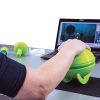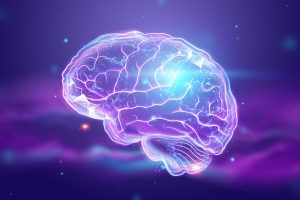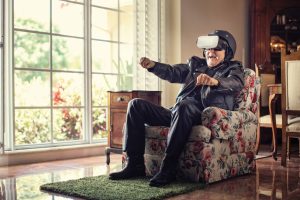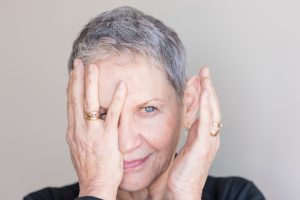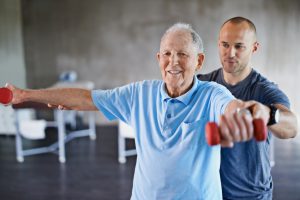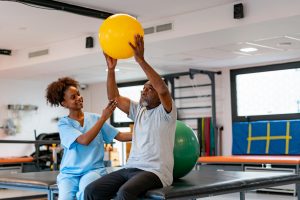
Neuromuscular Reeducation in Occupational Therapy
Treatment GuidelinesNeuromuscular reeducation is the intersection between neurological relearning and functional rehabilitation. In occupational therapy, it is often the “how” behind the inspiring rehabilitation journeys of our most severe cases. In this article, we’ll uncover why this approach works, how to objectively measure progress, and which treatment techniques to use with your patients.
Neuromuscular reeducation is the intersection between neurological relearning and functional rehabilitation. In occupational therapy, it is often the “how” behind the inspiring rehabilitation journeys of our most severe cases. In this article, we’ll uncover why this approach works, how to objectively measure progress, and which treatment techniques to use with your patients.
Defining Neuromuscular Reeducation
Neuromuscular reeducation is a specialized rehabilitation approach in occupational therapy. It aims to restore movement patterns by engaging the nervous system during exercise. As a result, patients gain enhanced motor control, coordination, and proprioception. All of this translates to improved functional ability in our occupational therapy patients.1
You can use neuromuscular reeducation activities to treat a variety of conditions. It is an essential tool in orthopedic and neurological rehabilitation. As an evidence-based practice, neuromuscular reeducation can benefit several conditions, including brain injury, stroke, and spinal cord injury, among other neurological diagnoses.2
Neurological Basis and Underlying Principles of Neuromuscular Reeducation
Now let’s get into the details to discover why neuromuscular reeducation is so effective in occupational therapy. Neuromuscular reeducation taps into the brain’s remarkable ability to adapt through learning, aka neuroplasticity. Neuroplasticity refers to the brain’s capacity to form new neural connections and reorganize existing ones in response to experience or injury.
In conditions like stroke or traumatic brain injury, neuroplasticity plays a crucial role in the recovery process. Damage in certain areas of the brain results in deficits in motor, sensory, or cognitive functions. In response to these challenges, the brain initiates neuroplastic changes to adapt to the new circumstances. This can involve routing neural pathways, recruiting neighboring areas, or strengthening existing connections. 2
As Occupational Therapists, we play a crucial role in promoting these neuroplastic changes to facilitate the rehabilitation process. We design rehabilitation programs that engage patients in meaningful tasks focused on functional movements. We tailor each activity to the individual’s specific deficits and personal motivation. Our guidance ensures that the activities are appropriate and challenging enough to promote neuroplasticity.
As our patients engage in purposeful and repetitive movements, the brain responds by refining its circuitry to enhance performance. This process can lead to significant improvements in motor skills, cognitive abilities, and overall quality of life.
Assessing Progress: Evaluation and Outcome Measures
A comprehensive evaluation includes a conversation with the patient and a series of physical tests. The conversation will determine the patient’s goals, motivation, and interests. The physical tests include assessing global functional deficits, movement patterns, balance, posture, coordination, strength, sensation, and proprioception. This physical evaluation lays the groundwork for tailoring a targeted treatment plan. We’ll perform these assessments in the initial evaluation and periodically to track changes and adjust our treatment activities.
Objective measurement is key for providing data-driven occupational therapy. In addition to patient self-reporting and our own observations, objective measures show concrete changes over time. This can be a powerful motivator for your clients as well as a clear indicator of the value of your services.
Let’s break down a few objective neuromuscular reeducation assessments by category:
- Arm function: Action Research Arm Test (ARAT), Box and Block Test, Fugl–Meyer Assessment (FMA), Motor Evaluation Scale for Upper Extremity in Stroke.
- Hand function: Nine Hole Peg Test, Purdue Pegboard Test,
- Reach: Functional Reach Test, Function in Sitting Test (FIST).
- Lower extremity function: Timed Up and Go, Five Times Sit to Stand Test
- Balance/Gait: Berg Balance Scale, Activities-Specific Based Confidence Scale, Stroke Rehabilitation Assessment of Movement (STREAM), Six Minute Walk Test, Modified Clinical Test of Sensory Interaction on Balance.
You likely won’t need to use each of these tests for each patient. Choosing the most appropriate tests depends on the patient’s condition, deficits, and goals. Once you have performed your evaluation, it’s time to build your treatment plan.
Neuromuscular Reeducation Treatment in Occupational Therapy
In occupational therapy, we craft our treatment plan based on the initial assessment. In most cases, you want to include a variety of modalities and evidence-based interventions. Up next, we’ll cover five major categories of neuromuscular reeducation treatment: proprioception, PNF, robotic devices / VR, high-intensity training, and NMES / FES.
Proprioception Training
Proprioception helps us know where we are in space. Boosting this awareness improves motor control and coordination. These exercises will often involve balance and stability training, such as standing on unstable surfaces like balance boards or foam pads. You can load additional weight to the affected limb to draw increased awareness to it. You can also use a mirror for visual feedback and postural awareness.
Proprioceptive Neuromuscular Facilitation (PNF)
PNF is a widely adopted treatment approach within neuromuscular rehabilitation. Focusing on patterns of movement and diagonal exercises, PNF stimulates both the peripheral and central nervous systems. It can decrease abnormal muscle tone and increase muscle activity. By integrating stretch and resistance, PNF uses dynamic and functional movements, with the overarching goal of improving motor control.3
New Neuromuscular Reeducation Treatment Tool for OT
This year, BTE introduced a brand-new hand therapy device for neuromuscular control and coordination training: the Capri. The Capri is an advanced therapeutic gaming system that addresses both orthopedic and neurologic conditions through occupational therapy sessions. With it you can:
- Rehabilitate orthopedic conditions and post-op
- Treat neurologic conditions such as TBI, stroke, Parkinson’s, ALS, and more
- Address neuromuscular control, motor control, and coordination
- Promote neural plasticity and adaption through gamified exercise
The Capri is an excellent neuromuscular reeducation tool for occupational therapy. The fun games keep clients engaged while promoting neuromuscular control and coordination. Learn more about how Capri can help your orthopedic and neurologic OT patients here: Functional Rehabilitation with Capri.
Robotic Devices & Virtual Reality (VR) for Motor Control and Task Specific Training
After the FDA’s first approval of a VR device for rehabilitation, occupational therapy and physical therapy clinics are exploring this intervention. What makes VR so effective for occupational therapy? Research shows it may have to do with the amount of functional movement involved.4,5 According to a recent study, traditional OT sessions result in 23-32 repetitions of a movement per session, while a one-hour VR session resulted in 200-300 functional movements.4,5 This repetition is essential for motor learning. These technologies help provide high-dose, task-repetitive movements, while minimizing therapist fatigue.
Technology can provide realtime data and visual feedback to individuals during treatment. Instant feedback can be really beneficial for neuromuscular control by promoting awareness and learning. For best results, we should include cognitive components in the treatment plan. This can include changing task demands, adding new variables, and always ensuring a sufficient challenge. We should always ensure our activities engage the patient in active problem-solving altering movement patterns to achieve their goal.6
High-intensity Training
Sweating it out with cardio isn’t just for fitness. Research shows that high-intensity training with a sustained elevated heart rate contributes to neuroplasticity.2 We can attribute this to an increase in the production of a protein called BDNF. High-intensity workouts that cause a release of BDNF, which essentially primes your brain for learning. High-intensity exercise during or before functional task activities can optimize the neurological benefits.7
Neuromuscular Electrical Stimulation (NMES) and Functional Electrical Stimulation (FES)
NMES stimulates the muscles with an electrical current. It works by stimulating a specific nerve to contract the target muscle. Repeated application can result in muscle strengthening. However, FES or Functional Electrical Stimulation adds a component of function to NMES. FES is essentially using NMES on specific muscle groups and in a specific sequence and timing to complete purposeful movements.9 Think brushing your teeth, grabbing a cup, or going from sitting to standing. This stimulation provides a multi-sensory input to the brain that can aid the motor recovery process.8 Research shows it’s effective for functional recovery of several neurological disorders, including spinal cord injury, stroke, and brain injury.8,9
Neuromuscular Reeducation for Healthy Aging
Beyond injury, neuromuscular reeducation extends its reach to healthy aging adults. With a natural decline in proprioception, vision, and vestibular systems as we age, this technique becomes a key player in reducing fall risk. Occupational Therapists can leverage these techniques to promote neuroplasticity and healthy aging.7
Conclusion
Neuromuscular reeducation is an essential tool in occupational therapy. With its ability to promote learning via neuroplasticity, it can benefit several neurological and musculoskeletal conditions. Your evaluations should include both a patient interview and objective measurements of functional abilities. Treatment interventions vary widely and depend on each individual patient. BTE’s Capri occupational therapy device offers personalized therapeutic gaming to improve neuromuscular control and coordination.
Ultimately, an approach that combines high-intensity exercise, repetition, and purposeful movement targeted towards functional goals will provide the best outcomes. There is no one-size-fits-all approach to neuromuscular reeducation but utilizing these principles will promote the best recovery outcomes for your patients.
Chelsea Haedrich, OTR/L is an Occupational Therapist and health writer. She has seven years of clinical experience across acute, inpatient rehab, and skilled nursing settings. Her career has focused primarily on neurological inpatient rehab, specifically spinal cord injury. Chelsea is passionate about patient education and increasing health literacy.


